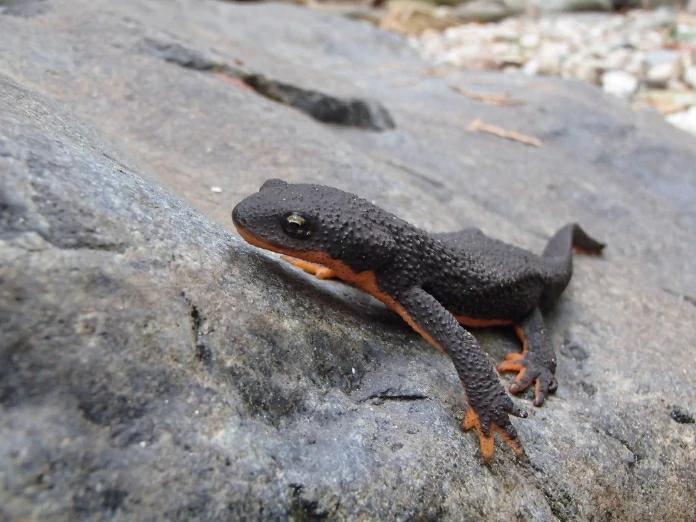You might have seen a newt in the wild and wondered: what are newts actually known for?
Newts are known for being able to regrow lost body parts, for living part of their life on land and part in water, and for having skin that’s toxic to predators. They’re also symbols of transformation in stories and play important roles in keeping ecosystems healthy.
They may look simple, but when you look closer, newts are full of surprises. Let’s see exactly what makes them special.
Newts Can Regrow Lost Body Parts
One of the most amazing things about newts is how they can regrow parts of their body. Lose a leg, a tail, or even part of an eye? A newt can grow it back completely.
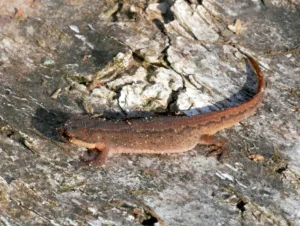
Scientists have studied this for years because humans can’t do it. We get scars, and lost limbs are gone forever.
But a newt’s body has special cells that act like stem cells, rebuilding the missing part as if nothing happened.
For example, if a predator bites off a tail, the tail slowly grows back over weeks or months. Not just a stump, but a full, working tail with nerves, muscles, and blood vessels.
This ability makes newts famous in science, and researchers hope one day it might help humans heal injuries.
Newts Have a Strange Three-Stage Life Cycle
Most animals stay the same as they grow. Birds hatch, grow feathers, and stay birds. Mammals get bigger but don’t transform completely.
Newts are different.
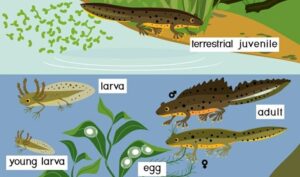
They go through three main stages:
-
Aquatic larvae: Hatch with gills and live in water like tadpoles.
-
Red eft (juvenile): Leave water, live on land, and turn bright orange or red.
-
Adult aquatic newt: Go back to water, turning olive green with spots.
This means you could see the same species in two very different forms, one crawling through leaves, the other swimming in a pond.
It’s like seeing two different creatures, yet it’s the same animal.
Newts Use Bright Colors to Warn Predators
If you see a red eft crawling across wet leaves, the color grabs your attention. That orange-red skin isn’t just pretty, it warns predators.
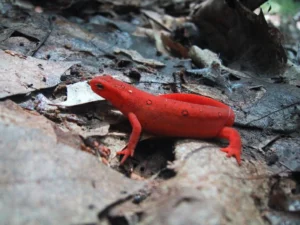
Newts produce toxins in their skin that make them taste bad or even poisonous. Bright colors tell birds, snakes, or fish: “Don’t eat me, I’m dangerous.”
This warning system is called aposematism. Other animals use it too, like monarch butterflies and poison dart frogs. Newts use their colors to survive in a world full of hungry mouths.
Newts Help Control Insects
Newts quietly help keep insects in check. In ponds, streams, and gardens, they eat:
-
Mosquito larvae
-
Worms
-
Slugs
-
Tiny crustaceans
-
Aquatic insects
By eating these, newts help keep insect numbers balanced. In wetlands where Eastern newts live, mosquito populations often stay lower.
That’s better for both the newts and the people nearby.
Newts Live Between Land and Water
Some animals stay on land, like squirrels. Others live in water, like fish. Newts do both.
Juvenile red efts crawl through the forest floor. Adults mostly swim in ponds and streams.
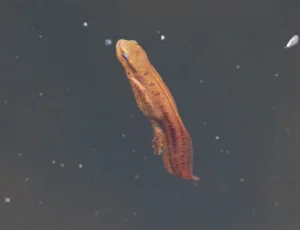
This double lifestyle makes them fascinating to watch. Hikers might spot them crawling through leaves, while pond-watchers see them swimming gracefully below the surface.
Few animals switch between land and water like this, and it makes newts stand out.
Newts Have Toxic Defenses
Their toxins usually don’t hurt humans unless swallowed, but they’re strong against predators.
Some species, like the rough-skinned newt in North America, produce enough poison to kill a predator many times their size.

There’s even a story of an evolutionary arms race: garter snakes evolved resistance to newt toxins, and newts became even more toxic in response.
It’s a natural battle written in skin chemistry, showing how tough newts can be.
Newts Appear in Folklore and Symbolism
For centuries, newts have shown up in myths and stories. In European tales, they were linked with magic, change, and mystery.
Some believed newts were ingredients in potions, symbols of transformation, or protectors of secret knowledge.
In Shakespeare’s Macbeth, witches chant about “eye of newt” in their potion. Historians think it probably meant a plant seed, but it shows how deeply newts were tied to mystical ideas.
Even today, spotting a newt in the wild can feel like a secret gift from nature.
Newts Show When Environments Are Healthy
Because newts need clean water to survive, seeing them means an ecosystem is healthy. Pollution, chemicals, or habitat loss can wipe them out fast.
So when you find newts thriving in a pond, it tells you the water is clean, plants are growing, and the ecosystem is balanced.
Scientists study amphibians like newts to track changes in the environment because they’re very sensitive to pollution.
Newts Are Escape Artists in Captivity
People who keep newts quickly notice they’re escape artists. They climb glass walls, squeeze through small gaps, and wander off if tanks aren’t sealed.
Stories of missing pet newts drying out behind furniture are common. Even in captivity, newts show their determination to explore.
Newts Are Quietly Beautiful
Unlike flashy parrots or noisy frogs, newts are subtle. They move slowly, tails swaying, eyes blinking calmly.
Watching them swim through plants or crawl under logs is peaceful, almost meditative.
People who study or keep them say part of their charm is this quiet beauty. They don’t demand attention, you have to slow down and notice them.
Conclusion
So what are newts known for? They’re known for regrowing lost body parts, their life cycle that shifts between land and water, and their toxins that protect them from predators.
They’re known for bright colors, insect control, and being signs of healthy ecosystems.
They appear in folklore as symbols of transformation and in science as models for regeneration. In captivity, they’re quiet, fascinating, and sometimes sneaky escape artists.
In short, newts are more than “little lizards”. They’re creatures of mystery, resilience, and quiet beauty, reminders that even the smallest animals can hold some of nature’s biggest secrets.
Hi, my name is Ezra Mushala, i have been interested animals all my life. I am the main author and editor here at snakeinformer.com.

